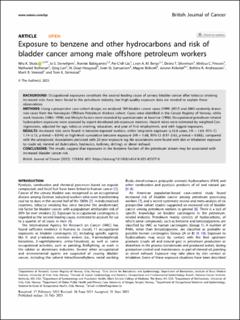| dc.contributor.author | Shala, Nita Kaupang | |
| dc.contributor.author | Stenehjem, Jo | |
| dc.contributor.author | Babigumira, Ronnie | |
| dc.contributor.author | Liu, Fei-Chih | |
| dc.contributor.author | Berge, Leon Alexander Mclaren | |
| dc.contributor.author | Silverman, Debra T. | |
| dc.contributor.author | Friesen, Melissa C. | |
| dc.contributor.author | Rothman, Nathaniel | |
| dc.contributor.author | Lan, Qing | |
| dc.contributor.author | Hosgood, H. Dean | |
| dc.contributor.author | Samuelsen, Sven Ove | |
| dc.contributor.author | Bråtveit, Magne | |
| dc.contributor.author | Kirkeleit, Jorunn | |
| dc.contributor.author | Andreassen, Bettina Kulle | |
| dc.contributor.author | Veierød, Marit Bragelien | |
| dc.contributor.author | Grimsrud, Tom Kristian | |
| dc.date.accessioned | 2024-01-03T11:44:00Z | |
| dc.date.available | 2024-01-03T11:44:00Z | |
| dc.date.created | 2023-08-02T10:57:06Z | |
| dc.date.issued | 2023 | |
| dc.identifier.citation | British Journal of Cancer. 2023, 129 (5), 838-851. | |
| dc.identifier.issn | 0007-0920 | |
| dc.identifier.uri | https://hdl.handle.net/11250/3109524 | |
| dc.description.abstract | Background Occupational exposures constitute the second leading cause of urinary bladder cancer after tobacco smoking. Increased risks have been found in the petroleum industry, but high-quality exposure data are needed to explain these observations. Methods Using a prospective case-cohort design, we analysed 189 bladder cancer cases (1999–2017) and 2065 randomly drawn non-cases from the Norwegian Offshore Petroleum Workers cohort. Cases were identified in the Cancer Registry of Norway, while work histories (1965–1998) and lifestyle factors were recorded by questionnaire at baseline (1998). Occupational petroleum-related hydrocarbon exposures were assessed by expert-developed job-exposure matrices. Hazard ratios were estimated by weighted Cox-regressions, adjusted for age, tobacco smoking, education, and year of first employment, and with lagged exposures. Results Increased risks were found in benzene-exposed workers, either long-term exposure (≥18.8 years, HR = 1.89, 95% CI: 1.14–3.13; p-trend = 0.044) or high-level cumulative benzene exposure (HR = 1.60, 95% CI: 0.97–2.63; p-trend = 0.065), compared with the unexposed. Associations persisted with 20-year exposure lag. No associations were found with skin or inhalation exposure to crude oil, mineral oil (lubrication, hydraulics, turbines, drilling), or diesel exhaust. Conclusions The results suggest that exposures in the benzene fraction of the petroleum stream may be associated with increased bladder cancer risk. | |
| dc.language.iso | eng | |
| dc.title | Exposure to benzene and other hydrocarbons and risk of bladder cancer among male offshore petroleum workers | |
| dc.title.alternative | Exposure to benzene and other hydrocarbons and risk of bladder cancer among male offshore petroleum workers | |
| dc.type | Peer reviewed | |
| dc.type | Journal article | |
| dc.description.version | publishedVersion | |
| dc.source.pagenumber | 838-851 | |
| dc.source.volume | 129 | |
| dc.source.journal | British Journal of Cancer | |
| dc.source.issue | 5 | |
| dc.identifier.doi | 10.1038/s41416-023-02357-0 | |
| dc.identifier.cristin | 2164442 | |
| cristin.ispublished | true | |
| cristin.fulltext | original | |
| cristin.qualitycode | 2 | |
